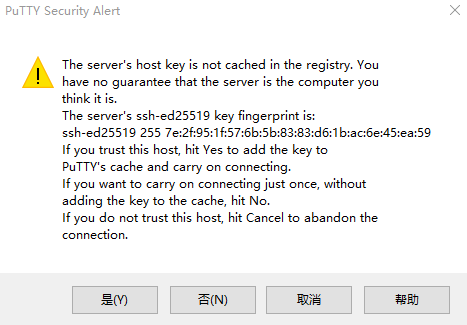10.1 ‘The server's host key is not cached in the registry’
This error message occurs when PuTTY connects to a new SSH server. Every server identifies itself by means of a host key; once PuTTY knows the host key for a server, it will be able to detect if a malicious attacker redirects your connection to another machine.
If you see this message, it means that PuTTY has not seen this host key before, and has no way of knowing whether it is correct or not. You should attempt to verify the host key by other means, such as asking the machine's administrator.
If you see this message and you know that your installation of PuTTY has connected to the same server before, it may have been recently upgraded to SSH protocol version 2. SSH protocols 1 and 2 use separate host keys, so when you first use SSH-2 with a server you have only used SSH-1 with before, you will see this message again. You should verify the correctness of the key as before.
See section 2.2 for more information on host keys.

中间人攻击
https://zh.wikipedia.org/wiki/Secure_Shell
Secure Shell(安全外壳协议,简称SSH)是一种加密的网络传输协议,可在不安全的网络中为网络服务提供安全的传输环境[1]。SSH通过在网络中创建安全隧道来实现SSH客户端与服务器之间的连接[2]。虽然任何网络服务都可以通过SSH实现安全传输,SSH最常见的用途是远程登录系统,人们通常利用SSH来传输命令行界面和远程执行命令。使用频率最高的场合类Unix系统,但是Windows操作系统也能有限度地使用SSH。2015年,微软宣布将在未来的操作系统中提供原生SSH协议支持[3],Windows 10 1809 版本已提供可手动安装的 OpenSSH工具[4]。
在设计上,SSH是Telnet和非安全shell的替代品。Telnet和Berkeley rlogin、rsh、rexec等协议采用明文传输,使用不可靠的密码,容易遭到监听、嗅探和中间人攻击[5]。SSH旨在保证非安全网络环境(例如互联网)中信息加密完整可靠。
不过,SSH也被指出有被嗅探甚至解密的漏洞。
基本架构
SSH协议框架中最主要的部分是三个协议:
- 传输层协议(The Transport Layer Protocol):传输层协议提供服务器认证,数据机密性,信息完整性等的支持。
- 用户认证协议(The User Authentication Protocol):用户认证协议为服务器提供客户端的身份鉴别。
- 连接协议(The Connection Protocol):连接协议将加密的信息隧道复用成若干个逻辑通道,提供给更高层的应用协议使用。
同时还有为许多高层的网络安全应用协议提供扩展的支持。
各种高层应用协议可以相对地独立于SSH基本体系之外,并依靠这个基本框架,通过连接协议使用SSH的安全机制。
SSH的安全验证
在客户端来看,SSH提供两种级别的安全验证。
- 第一种级别(基于密码的安全验证),知道帐号和密码,就可以登录到远程主机,并且所有传输的数据都会被加密。但是,可能会有别的服务器在冒充真正的服务器,无法避免被“中间人”攻击。
- 第二种级别(基于密钥的安全验证),需要依靠密钥,也就是你必须为自己创建一对密钥,并把公有密钥放在需要访问的服务器上。客户端软件会向服务器发出请求,请求用你的密钥进行安全验证。服务器收到请求之后,先在你在该服务器的用户根目录下寻找你的公有密钥,然后把它和你发送过来的公有密钥进行比较。如果两个密钥一致,服务器就用公有密钥加密“质询”(challenge)并把它发送给客户端软件。从而避免被“中间人”攻击。
在服务器端,SSH也提供安全验证。 在第一种方案中,主机将自己的公用密钥分发给相关的客户端,客户端在访问主机时则使用该主机的公开密钥来加密数据,主机则使用自己的私有密钥来解密数据,从而实现主机密钥认证,确保数据的保密性。 在第二种方案中,存在一个密钥认证中心,所有提供服务的主机都将自己的公开密钥提交给认证中心,而任何作为客户端的主机则只要保存一份认证中心的公开密钥就可以了。在这种模式下,客户端必须访问认证中心然后才能访问服务器主机。

@@@@@@@@@@@@@@@@@@@@@@@@@@@@@@@@@@@@@@@@@@@@@@@@@@@@@@@@@@@
@ WARNING: REMOTE HOST IDENTIFICATION HAS CHANGED! @
@@@@@@@@@@@@@@@@@@@@@@@@@@@@@@@@@@@@@@@@@@@@@@@@@@@@@@@@@@@
IT IS POSSIBLE THAT SOMEONE IS DOING SOMETHING NASTY!
Someone could be eavesdropping on you right now (man-in-the-middle attack)!
It is also possible that a host key has just been changed.
The fingerprint for the ECDSA key sent by the remote host is
SHA256:+d0Vv9UBHEsKI1r6QhF1QHz9ytvOS/OEe9zuyJNF4qk.
Please contact your system administrator.
Add correct host key in /root/.ssh/known_hosts to get rid of this message.
Offending ECDSA key in /root/.ssh/known_hosts:10
remove with:
ssh-keygen -f "/root/.ssh/known_hosts" -R "sit2test"
ECDSA host key for sit2test has changed and you have requested strict checking.
Host key verification failed.